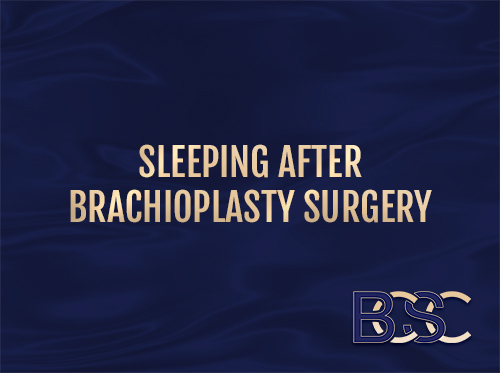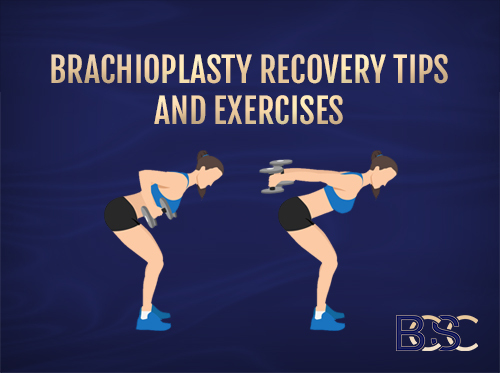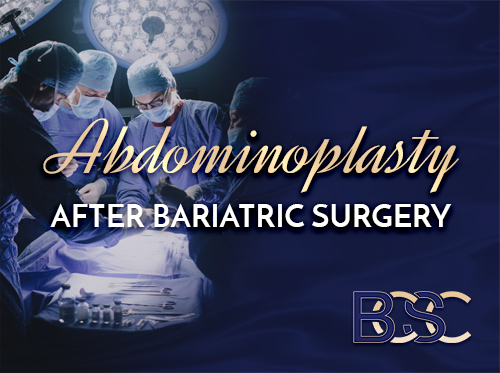Brachioplasty Cost Considerations
Australia arm lifts cost 5000 to 10000 AUD on average. Surgeons charge different rates based on their expertise, location, and the type of arm lift. Anesthetist and hospital fees cost extra. Private health cover and Medicare rebates may reduce out-of-pocket costs.
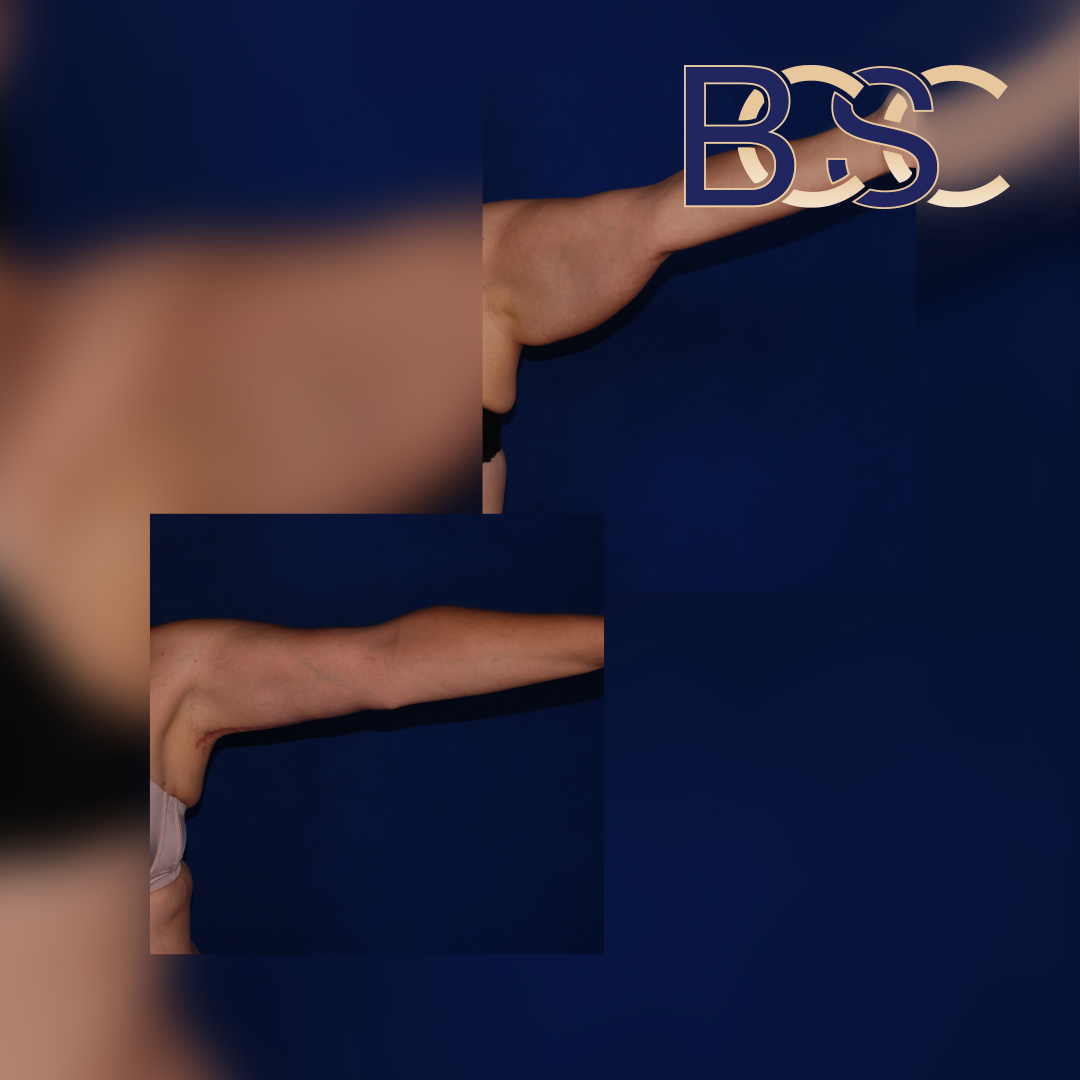
Disclaimer: Operation performed by Dr Bernard Beldholm. Adult content, surgery has risks; individual results vary, seek 2nd opinion. Please see the full disclaimer.
What is the most significant factor that affects the cost of arm lift surgery?
Qualifying for the Medicare rebate for arm lift surgery in Australia (MBS Item # 30169) can significantly lower out-of-pocket costs. If you have Gold-level private health coverage, the cost may decrease further.
Medicare Rebate in Australia

The Australian government offers a Medicare rebate to patients who meet the criteria for medical services listed in the Medicare Benefits Schedule (MBS). The rebate will not cover the total cost of medical services related to procedures such as arm lift surgery. However, it can lessen a patient’s financial burden. The patient is responsible for paying the difference out-of-pocket.
MBS Item 30169 | Medicare Benefits Schedule

Who It’s For
This item number is only valid for post-weight loss patients who will undergo an arm lift for functional or clinically necessary reasons.
Rules and Prerequisites
- The excess skin and subcutaneous fat must be a direct result of massive weight loss, defined as losing 5 BMI units or more, not including weight gained or lost during pregnancy.
- While most candidates have lost weight through bariatric surgery, you can still apply if you have lost weight the old-fashioned way so long as you can provide medical records to confirm the number of BMI units lost.
- You have maintained a stable weight for at least six months after losing weight.
- You must have intertrigo or another skin condition that poses a risk to the skin integrity, which hasn’t resolved with three months of conservative treatment.
- Removal of the excess skin and fat is not intended for the purpose of weight loss or cosmetic enhancement.
- The excess skin interferes with your daily activities.
- You must be a citizen or private resident of Australia.
What it Covers
The Medicare rebate typically covers a portion of the anaesthetist fee and surgeon fee. If you have Medicare and a private health fund, you can get up to 100% of the MBS Schedule Fee back. If you only have Medicare, you will be responsible for paying hospital fees out-of-pocket.
How it Works

To claim the Medicare rebate for arm lift surgery (brachioplasty), you will first need a referral from your General Practitioner. Only then can you speak to a specialist surgeon. The GP referral is usually valid for up to 12 months.
Diagnostic imaging, photographs, documented symptoms of pain and discomfort, documentation showing how many BMI units were lost, and evidence of failed conservative therapy for skin conditions must be submitted with the application. Your GP should be keeping records of all this.
Private Health Insurance Coverage
If you meet the strict criteria for the Medicare rebate, you might also be eligible for additional rebates from your private health insurance provider. If you have a private health fund, you must call to ask if they cover the MBS item number for your specific policy. If not, you can upgrade your private health plan, but doing so typically delays the process by a year, known as the ‘exclusion period’.
How do I find out how much an arm lift costs?
You can expect to pay some costs out-of-pocket, even if you qualify for Medicare or private health fund rebates. To determine how much you will pay for arm lift surgery, you will need to speak to a specialist surgeon. This will require a referral from your GP.
Your First Consultation
During your initial consultation, you can expect your specialist surgeon to examine your skin elasticity, ask what you hope to accomplish with an arm lift, review your medical history, tell you about the risks of surgery, and create a surgical plan to address sagging skin or extra fat on your upper arms.
Most surgeons charge a consultation fee. You may get money back for this if you qualify for Item 104 in the Medicare Benefits Schedule.

Your Second Consultation
Patients usually need to return to the specialist surgeon for a second consultation. At this point, the surgeon’s patient coordinator will provide an exact price quote for the surgeon fee and start gathering the hospital and anaesthetist price quotes.
Arm Lift Costs to Consider
The price quote you receive may list separate costs for the surgeon fee, anaesthesia fee, and hospital fees.
Hospital Fee
If you have private insurance, the cost of the hospital may be covered depending on your policy and level of cover. If you do not have private insurance, expect to pay all hospital charges out-of-pocket.
Each hospital charges different rates affected by the length of your hospital stay, the amount of time spent in the operating room, and additional operative costs.
- Day stay: Hospital fee is usually 1000 or less
- Overnight stay: Hospital fee is usually between 1000-1600
- Operation Time: Hospitals usually charge between 1200-1500 per hour
- Additional Operative Costs: Extra fees typically range between 1200-1500 for ancillary items such as ARTISS tissue glue, etc.
Anaesthetist Fee
An arm lift operation will require general anesthesia administered by a licensed anaesthetist. Each anaesthetist determines their own fee schedule. Pricing typically ranges between 600-800 per hour, but can vary.
*You will get a health fund rebate back for the anaesthetist fee if you qualify for the MBS item #.
Surgeon Fee
The surgeon fee will depend on the complexity of the arm lift and the time it takes to perform the surgery. A surgeon’s experience, geographic location, and credentials can also factor into pricing.
*You will get a partial health fund rebate for the surgeon fee if you qualify for the MBS item #. Note that a mini arm lift is not covered by the MBS item number, so those patients can expect to pay all costs out-of-pocket.
Mini Brachioplasty

A mini arm lift is usually the least expensive option since it removes the least amount of loose skin and excess fat.
- Operation Time: 1.5 to 2 hours
- Surgeon Fee: Typically between 4500-6000, but can vary
- Covered by MBS Item # 30169: No
Full Brachioplasty

A full arm lift usually costs more than a mini arm lift, but less than an extended arm lift. This arm lift procedure removes a significant amount of loose skin and excess fat from the upper arms. It’s the most common type of arm lift.
- Operation Time: 3 to 4 hours (depending on how big the arm is)
- Surgeon Fee: Typically between 6000-9000, but can vary
- Covered by MBS Item # 30169: Yes, strict criteria apply
Extended Brachioplasty
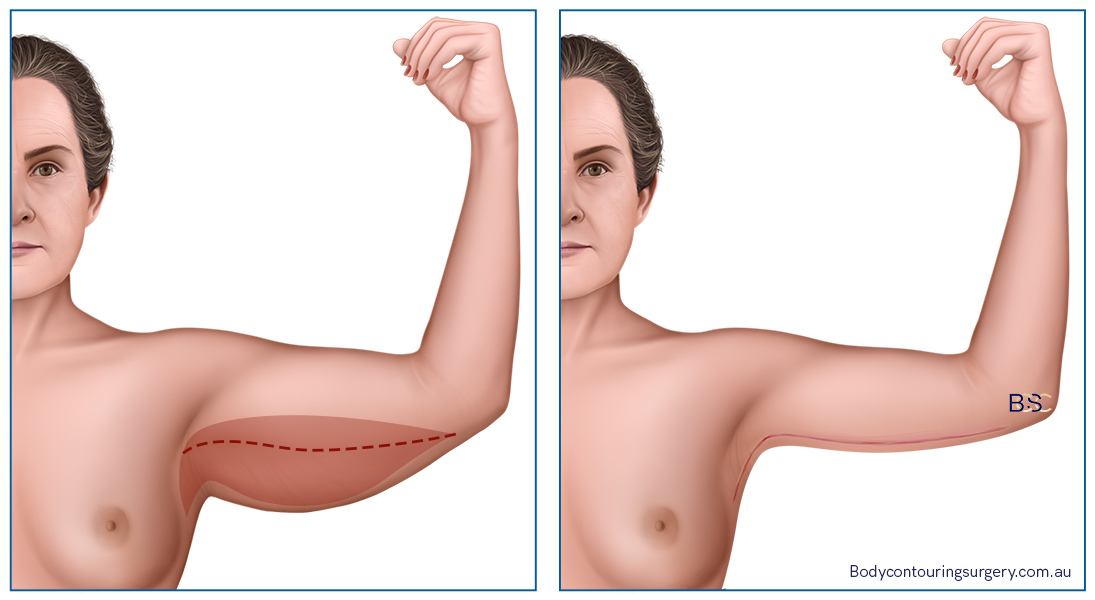
An extended upper arm lift usually costs the most since it removes excess skin from both the upper arms and the sides of the chest. It’s usually reserved for patients with extremely sagging skin and excess fat after significant weight loss.
- Operation Time: 4 to 5 hours (depending on the extent of surgery)
- Surgeon Fee: Typically up to 10,000, but can vary
- Covered by MBS Item # 30169: Yes, strict criteria applies
Liposuction-based Arm Lifts
Add-on services such as liposuction will likely increase the surgeon’s fee and hospital fee due to the extra time spent in the operating room. Most arm lift patients find it is usually well worth the additional cost since liposuction further refines the upper arm by removing fat deposits.
We spoke to specialist general surgeon Dr Bernard Beldholm, and he says he often performs VASER liposuction and arm lifts as a combined procedure. His technique is called a VASER-assisted arm lift. In his 12+ years of experience as a FRACS surgeon, he has found this results in the most refined brachioplasty outcomes.
Additional Financial Factors
Most arm lift patients only think about the big expenses like the surgeon, hospital, and anaesthetist fees. However, if you’re planning to undergo arm lift surgery, there may be other financial factors to consider.
- You’ll need to take time off of work (usually two to three weeks) to recover from arm lift surgery.
- You may need to hire a nanny or babysitter to tend to your kids if you don’t have family members to assist with childcare as you heal.
- If you have a surgical complication, any medical services necessary to manage the complication will cost extra. *Australians that qualify for MBS Item 30169 usually do not pay extra costs if they have a complication.
- If you don’t have a family member to assist with driving as you heal from surgery, you may need to pay for transportation to attend follow-up appointments with your surgeon.
- You may spend money upgrading your wardrobe if your arm shape changes significantly.
Receive a Price Quote for Arm Lift Surgery Today
To learn the exact cost of arm lifts in Sydney, Newcastle, Hunter Valley, and the surrounding areas, ask your GP for a referral to speak with a surgeon at Body Contouring Surgery Clinic.
FAQs
How much does an arm lift in Sydney cost?
You’ve probably searched online to find out the average cost of arm lifts in Sydney and surrounding areas. The surgeon fee can range between 5000 to 10000 AUD. Additional expenses such as the anaesthetist and hospital fee may be covered in part or full depending on the patient’s private health policy and whether they qualify for a Medicare rebate. To get an exact price quote for a Sydney arm lift, your first step is getting a referral from your GP so you can speak to a qualified surgeon.
Is it possible to get a free arm lift in Australia?
No. Patients will always have some out-of-pocket costs, regardless of whether they are eligible for a Medicare rebate or have top-level private health insurance.
Will insurance cover arm lift surgery in AUS?
If you have private health cover, your plan may cover some or all of the hospital fees depending on your policy and level of coverage.
How else can I prepare for an arm lift procedure?
You’ll likely need to adjust your lifestyle and current medications to prepare for surgery. For example, you may need to stop smoking and avoid nonsteroidal anti inflammatory drugs. The initial healing process usually lasts two to three weeks, so you’ll need to plan time off work, arrange for childcare assistance, and find reliable transportation to and from the hospital.
What else should I know before deciding to have brachioplasty?
Realistic expectations are crucial. Brachioplasty surgery won’t make you look like a celebrity or reinvent your life. The procedure can, however, remove extra skin, get rid of stubborn fat, reduce rashes and discomfort from extra skin, and improve the appearance of the upper arms. Ideal candidates have reached their goal weight and are physically healthy.
What is the recovery like after an arm reduction procedure?
Many patients take two to three weeks off of work to recover. At that point, they usually feel well enough to resume normal activities like driving. Full healing can take anywhere from six weeks to three months. For optimal results, you will likely need to wear a compression garment to reduce swelling as you heal. You will also need to maintain a stable weight to keep your arms toned after the procedure.
Will I need to stop smoking?
Upper arm lift patients must quit smoking before and after the procedure. Otherwise, it can lead to complications. You may be able to have an upper arm lift if you quit a few weeks to months before the surgery and remain dedicated to a smoke-free lifestyle for several months afterward.
What do arm lift scars look like?
The ideal candidate for an arm lift procedure understands that there will be a surgical scar. In a full arm lift, the scar is usually placed on the back or inside aspect of the upper arms. The scar should eventually blend in with the nearby skin, but will never disappear completely. It can take a year or longer for the surgery scars to mature. Be sure to protect the scar site from the sun until the scar fades.

